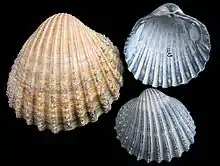Acanthocardia echinata
Acanthocardia echinata, the prickly cockle or European prickly cockle, is a species of saltwater clam, marine bivalve molluscs in the family Cardiidae. The genus Acanthocardia is present from the Upper Oligocene to the Recent.
| Acanthocardia echinata | |
|---|---|
 | |
| Scientific classification | |
| Kingdom: | Animalia |
| Phylum: | Mollusca |
| Class: | Bivalvia |
| Subclass: | Heterodonta |
| Order: | Cardiida |
| Family: | Cardiidae |
| Genus: | Acanthocardia |
| Species: | A. echinata |
| Binomial name | |
| Acanthocardia echinata | |
The prickly cockle was one of the many invertebrate species originally described by Carl Linnaeus in his landmark 1758 10th edition of Systema Naturae, where it was given the binomial name Cardium echinatum.[1]
The yellowish-brown shell is up to 75 mm in diameter, and is adorned by 18 to 22 spiny ridges. Its margin is crenulate and its inner surface is white, and also prominently grooved.[2]
The prickly cockle is found in the British Isles and northwestern Europe. It lives within a few centimetres of the sea bottom, at depths of 3 m or more. Dead shells are commonly washed up on the beach.[2]
References
- Linnaeus, Carl (1758). Systema Naturae per Regna Tria Naturae, Secundum Classes, Ordines, Genera, Species, cum Characteribus, Differentiis, Synonymis, Locis (in Latin). Vol. I (10th revised ed.). Holmiae: (Laurentii Salvii). p. 679 – via The Internet Archive.
- Fish, J. D.; Fish, Susan (2011). A student's guide to the seashore (3rd ed.). Cambridge University Press. p. 268. ISBN 9781139494519.
External links
- Photos of Acanthocardia echinata on Sealife Collection